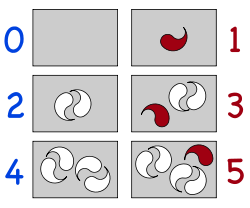Parity of zero

Parity of zero is the question whether the number zero is even or odd. General consensus is that the number is even. Even numbers are defined to be integer multiples of two. That way, the numbers two, four and six are even, because they are one times two, two times two, and three times two. With that explanation, zero is also even, because it is zero times two.
Another explanation is from number theory: The integers are arranged in such a way that even numbers are followed by odd ones, and odd ones by even ones. Zero is preceded by minus one, and followed by one. Both numbers are odd. So it must be even.
There is also a problem: The term "even" meaning "integer multiple of two" is a convention; people agreed on it. It is not a formal definition. Another case where people used a convention they agreed on was that of prime number: Before the 20th century, there were many inconsistent definitions of prime: Mathematicians such as Goldbach, Lambert, Legendre, Cayley, and Kronecker wrote that 1 was prime.[1] The modern definition of "prime number" is "positive integer with exactly 2 factors", so 1 is not prime. This definition is rational: it naturally suits mathematical theorems that concern the primes. For example, the fundamental theorem of arithmetic is easier to state when 1 is not considered prime[2]
It would be possible to redefine "even" in a way that no longer includes zero. However, in this case, the new definition would make it more difficult to state theorems concerning the even numbers. Already the effect can be seen in the algebraic rules governing even and odd numbers.[3] The most relevant rules concern addition, subtraction, and multiplication:
- even ± even = even
- odd ± odd = even
- even × integer = even
Inserting appropriate values into the left sides of these rules, one can produce 0 on the right sides:
- 2 − 2 = 0
- −3 + 3 = 0
- 4 × 0 = 0
The above rules would therefore be incorrect if zero were not even.[3] At best they would have to be modified. For example, one test study guide asserts that even numbers are characterized as integer multiples of two, but zero is "neither even nor odd".[4] Accordingly, the guide's rules for even and odd numbers contain exceptions:
- even ± even = even (or zero)
- odd ± odd = even (or zero)
- even × nonzero integer = even[4]
Making an exception for zero in the definition of evenness forces one to make such exceptions in the rules for even numbers. From another perspective, taking the rules obeyed by positive even numbers and requiring that they continue to hold for integers forces the usual definition and the evenness of zero.[3]
Parity Of Zero Media
Statistical analysis of experimental data, showing separation of 0. In this smallest space analysis, only the clustering of data is meaningful; the axes are arbitrary.
References
- ↑ Caldwell & Xiong 2012, pp. 5–6.
- ↑ Gowers 2002, p. 118 "The seemingly arbitrary exclusion of 1 from the definition of a prime … does not express some deep fact about numbers: it just happens to be a useful convention, adopted so there is only one way of factorizing any given number into primes." For a more detailed discussion, see Caldwell & Xiong (2012).
- ↑ 3.0 3.1 3.2 Partee 1978, p. xxi
- ↑ 4.0 4.1 Stewart 2001, p. 54 These rules are given, but they are not quoted verbatim.
Bibliography
- Caldwell, Chris K.; Xiong, Yeng (27 December 2012), "What is the Smallest Prime?", Journal of Integer Sequences, 15 (9), arXiv:1209.2007
- Gowers, Timothy (2002), Mathematics: A Very Short Introduction, Oxford University Press, ISBN 978-0-19-285361-5
- Partee, Barbara Hall (1978), Fundamentals of Mathematics for Linguistics, Dordrecht: D. Reidel, ISBN 90-277-0809-6
- Stewart, Mark Alan (2001), 30 Days to the GMAT CAT, Stamford: Thomson, ISBN 0-7689-0635-0






